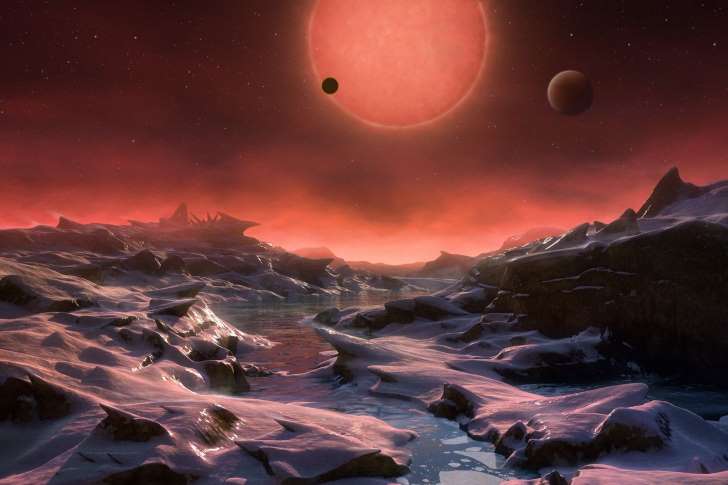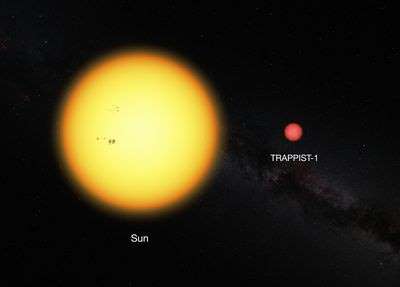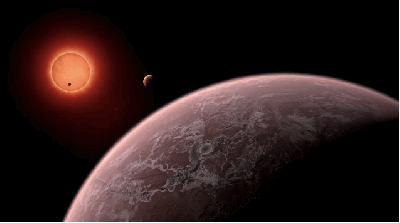May 2, 2016
Researchers have found a trio of Earth-sized planets that orbit around a small, super-cool star nearly 40 light years away. These planets orbit close enough to their host star that they're similar in temperature to Earth. That opens up the possibility that water could pool on their surfaces.

Maybe the best chance yet of finding extraterrestrial life
May 2, 2016
Researchers have found a trio of Earth-sized planets that orbit around a small, super-cool star nearly 40 light years away. These planets orbit close enough to their host star that they're similar in temperature to Earth. That opens up the possibility that water could pool on their surfaces.

Maybe the best chance yet of finding extraterrestrial life
The discovery of the three planets — published today in the journal Nature — is exciting news for astronomers. Earth-sized exoplanets are usually hard to study because they’re relatively small; if they orbit bright stars like our Sun, they are often overwhelmed by intense starlight, making them difficult to see and study. But the three planets described in the study orbit a much fainter star and are relatively close to Earth. That means that astronomers will be able to measure the elements in their atmospheres in more detail than ever before, providing clues as to what lies on the surfaces below.
Because of this, these planets may represent astronomers' best chance yet of finding life outside our Solar System. "These will be among the best examples to get a good measurement of an atmosphere that is approaching Earth-like temperatures," said Bruce Macintosh, an exoplanet expert at Stanford University, who was not involved in the study. "It's a beautiful laboratory for these kinds of measurements."
Astronomers were able to find the three planets by using the TRAPPIST telescope at the La Silla Observatory in Chile. The researcher looked in the very near-infrared, a spectrum of light in which fainter stars can be detected. They ultimately found a tiny, reddish star, called TRAPPIST-1 — a dwarf star that is only slightly bigger than Jupiter and is so small and faint that it can’t be observed directly with the naked eye. Using larger telescopes to make follow-up observations, the research team was able to find the three orbiting planets by looking for variations in the star's brightness. When the planets passed in front of TRAPPIST-1, they dimmed the star very slightly. Based on that dimming, the researchers were able to figure out the approximate size and location of the planets.

A comparison of the Sun to TRAPPIST-1. (ESO)
Two of the planets orbit very closely to the host star. The distance between TRAPPIST-1 and the nearest planet is just 1.1 percent the distance between Earth and the Sun; the second closest planet is 1.5 percent the Earth–Sun distance. Because they are so close, the planets receive between two to four times as much radiation exposure from the faint star as Earth gets from the Sun. That makes them probably too hot for water to pool on their surfaces. But these two planets are also tidally locked with TRAPPIST-1, meaning one side of each planet is facing the dwarf star at all times. It's possible that these planets' "night sides" — the sides that are in constant darkness — are just the right temperature for liquid water to exist.
"It’s possible the outer one is in the habitable zone."
Perhaps, the best candidate for finding water is the third outer planet. Its orbit and distance from TRAPPIST-1 aren't well defined just yet, but lead study author Michaël Gillon says the planet is far enough that it certainly receives less solar radiation exposure than Earth does. That means it may be the right temperature for liquid water to exist. "It’s possible the outer one is in the habitable zone," said Gillon.
This is the first time that astronomers have found Earth-sized planets orbiting such a tiny, dwarf star of this kind, the study claims. Dwarf stars like TRAPPIST-1 are thought to be in abundance throughout the Milky Way Galaxy, and they make up about 15 percent of the types of stars near our Solar System. Because TRAPPIST-1 is both super faint and relatively close to Earth, researchers will be able to keep studying the planets in detail. For example, by observing how the star’s light changes when the planets pass in front of it, researchers can make informed guesses about the planets’ atmospheres, discovering if water or carbon dioxide can be found there. And once stronger telescopes like NASA's James Webb Space Telescope becomes operational in 2018, astronomers will be able to get even more answers about the planets.

The Earth-sized planets are a big find. Until now, scientists have really only been able to study the atmospheres of bigger, Jupiter-sized planets that can be seen more easily. But those planets typically are not very Earth-like. "Those are big balls of gas or planets that are much bigger than the Earth and not at all habitable," said Gillon. "This is the first time we have planets we can study in extreme detail and are really like the Earth in terms of size, temperature, and composition."
Though that prospect is exciting, Macintosh cautions not to get too excited about these planets until we know exactly what they're made of. "It’s a really nice result but it doesn't necessarily mean that these are going to be rocky habitable planets," he said. "One important caveat when you discover planets with transits like this is you don’t know their mass, just their radius."
And even if signs of life are found on these planets, it's unclear what the next steps will be. "At 40 light years away, we’re very limited in what we can do," said Gillon. "We can study these planets for their chemical compositions, but after that we’d have to be very patient."
Courtesy: The Verge







































































































